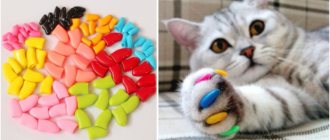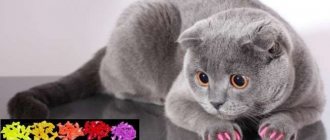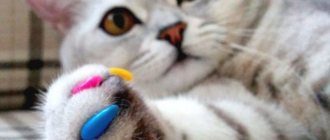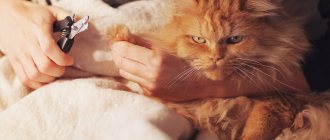Save the article:
Silicone caps that are placed on cats’ claws to prevent damage to furniture and the owner’s feet are called anti-scratch caps. In the last century, veterinarian Toby Wexler thought about solving the problem of cats scratching everything around. Since he was an ardent opponent of onychectomy - surgery to remove claws, he offered the world anti-scratch products for cats .
People can often hear such a silicone device called a cat manicure. Cats, indeed, look funny with a bright coating on their claws: manufacturers offer a large selection of colors for such silicone pads. In addition to the fact that the pussy looks stylish, such attachments have noticeable benefits: the furniture remains without traces of cat scratches, and household members sigh calmly without the pain of scratched skin.
The protective pads are glued with non-toxic special glue, and after 2-3 days the animal completely gets used to the newfangled safe manicure.
What are silicone anti-scratch pads for?
The point of anti-scratch for cats is to protect the owner's property: it is doubtful that anyone will like the torn furniture. Everything that the pet previously diligently tried to tear with its claws will remain intact: the cat will no longer spoil the wallpaper, door frames, tablecloths, sofas, armchairs, carpets. In a word, all things in the house will remain intact.
Those who especially often suffered from sharp cat claws can breathe easy: there will be no scratches on their hands, which serve as open gates for any infection, and a particularly zealous cat will not be able to damage children’s eyes. Cultured cat paws will protect the health of the whole family.
For people whose health is compromised, who have allergies, poor blood clotting or immunodeficiency syndrome, any scratch is dangerous. And funny silicone caps will prevent harm to the health of such a person.
So, what are the benefits of soft claws for cats :
- peace of mind for all family members: you can play with the cat without expecting a clawed trick from her;
- calmness of the pet: there are no consequences from claws - there is no reason for the owner to be angry;
- maintaining the health of all household members;
- apartment furnishings unspoiled by claws.
Thanks to Toby Wexler for his useful invention!
Are anti-scratch products harmful to cats?
global $ads_google;
//data-ad-slot=”2475549904″ $ads_google = empty($ads_google) ? false : true; ?> if ($ads_google == false) {?> $ads_google = true; ?> } ?> First, any cat will try to chew and remove the unusual covering in any way. Then a worm of doubt immediately begins to gnaw at the caring owner - is the pet suffering from such a manicure?
According to information from manufacturers, silicone tips are a completely safe material. Even if the cat accidentally swallows the anti-scratch, it will come out naturally. The only exception may be if your pet is allergic to glue, which itself is not toxic.
However, there are various myths floating around such an interesting colorful device. To dispel all doubts, let's consider all the disadvantages of a rubber cat manicure:
- noisy movement around the house - the sound with which an animal moves is impossible not to hear. The sound of a cat trying to grind off its claws is not very pleasant. As a solution, it is proposed to wear anti-scratch pads only on the front paws;
- fragility of the caps. A nimble and active cat will wear out the product in a month. There are zealous creatures that manage to remove the caps in the first couple of days. In this case, replaceable nozzles should be ready;
- takes a long time to get used to - the cat will be unfamiliar with such an innovation, and walking at first will be uncomfortable.
If you listen to reviews about rubber covers for claws, then besides the fact that the cat needs to get used to them, there is nothing negative.
What are scratches?
Scratchies are soft caps made of polypropylene that are glued with special glue to the claws of cats and dogs. Scratch pads for cats and dogs come in different sizes.
What colors of cat scratchers do we have?
fluorescent white yellow orange red purple.
light pink pink transparent blue blue black.
The color of the caps also plays an important role, it can be the same as your manicure, or the color of your pet’s eyes, or contrast with the background of the wallpaper in your apartment, or you can go further and alternate colors, for example, yellow and black if your favorite operator is Beeline . Imagine!
Do scratches have a size?
Yes, I have. Scratchies come in different shapes and sizes and for different animals. At the moment we offer one size for cats from 6 months to “retirement” and five sizes of scratches for dogs.
What colors and sizes of dog scratches do we have?
learn more about scratching for dogs...
What are cat scratchers for?
Scratchers have three main functions.
1) Cat scratchers protect your property from the claws of your pets and prevent its damage, namely, sofas, armchairs, ottomans, pillows, sofas and any other upholstered furniture will not be damaged or torn. Paper wallpaper and especially washable wallpaper, tablecloths, oilcloths, cardboard boxes, door frames, window frames and, in general, everything that catches the cat’s eye will not be scratched and the appearance of these things will remain presentable.
2) While playing with your pet, your hands will not be scratched and bacteria, viruses, and parasites will not get into the scratches on your hands. If there are children in the family, then in the process of playing the cat can scratch the child’s face and even eyes, because children do not always understand that they are hurting the cat. Therefore, scratching helps maintain your health and safety. In addition, the cat will not wake you up early in the morning on a weekend with the sounds of tearing something apart.
3) And thirdly, this aesthetic component. Your cat will look stylish and glamorous. And this, of course, will cause exclamations of surprise from all the guests who come to you.
At what age is it best to start scratching cats?
For owners of kittens that are 2-3 months old, we do not recommend using scratchers, since the claws are still small and they do not cause so much harm to you or your things. It is best to do this from 6 months, when cats begin their play period and their claws have already grown. When a cat is at “pre-retirement” age, she no longer wants to scratch anything and there is no need to do anything about it.
Will the cat try to chew the caps and what will happen if she swallows them?
Some cats actually try this, but after a few days they get used to it and don't notice the scratches on their claws. If they swallow the cap, it will not cause any harm since it is soft plastic that is not digested by the digestive system.
What is the service life of scratches?
The recommended period of use has nothing to do with the physical properties of the cap, but is directly related to the physiology of the claws. The keratinized layer of a cat's claw falls off about once every 1-2 months, and it turns out that the scratches are attached specifically to the claws. No one is stopping you from re-gluing this cap, but it’s better to stock up on scratches in advance.
How many caps are there in a box?
There are 20 caps in a box. The cat has 18 claws. 5 on the front legs and 4 on the hind legs. Therefore, you have 2 caps left in stock. And if you decide to put them on only the front paws, then you have all 10 caps in stock. If you want to buy several boxes at once and, say, stock up for six months, then we have a system of discounts.
Does gluing scratches harm your cat?
No it doesn't harm. The kit includes a special glue that is used in surgery. After gluing (if you did everything correctly), the cat will still be able to put its claws in and out and will mentally feel that it has claws and will behave as before, trying to scratch everyone, defending its independence.
What are the advantages of scratching over a scratching post?
The scratching post diverts the cat's attention from household things to the scratching post and she does not tear apart sofas and armchairs, but tears the scratching post to smithereens. The cat still needs to be accustomed to the scratching post, and it does not guarantee that the cat will not tear, say, wallpaper. A scratching post takes up some space in the house and can spoil the interior and create garbage (if it is made of cardboard). Your hands will still get scratched when you try to play with the cat.
Do you sell scratches wholesale?
Yes, we sell scratches wholesale and retail. You can see the price breakdown depending on quantity in the Prices tab. In total, the more scratches you buy, the lower the price. If you want to buy less than 10 packages, then you can find out the price from our manager.
Reviews from veterinarians about anti-scratch products for cats
In addition to ordinary cat lovers, it is worth asking the opinion of veterinarians on the issue of cats wearing rubber caps. The opinion of experts is not so rosy, since in any case, for cats, the procedure of gluing the pads is equal to stress.
A cat under natural conditions can grind its claws down if necessary, but a kitty with a bright manicure is forcibly deprived of this instinctive ability. This is also stressful for the animal. You should not think that the purr is adapting - most likely, this is not adaptation, but humility.
Veterinarians do not recommend anti-scratch kits for cats that have the opportunity to walk - in case of danger, she will not be able to defend herself and climb a tree.
Veterinarian consultation
Many people are afraid that their cat’s claws will itch under the pads.
This is not true, since the keratinized epithelium, which is the claws, cannot itch.
As an example, women’s nails under silicone or acrylic coatings do not itch.
Worries about the fact that the caps will need to be removed over time and that it will hurt the cat are also considered unfounded.
The overlays usually fall off on their own along with the regrown keratinized top layer of the claw.
Don't worry about your gait either.
Even if in the first hours the animal walks strangely and carefully, as if feeling the surface and raising its paws high, this will pass very quickly.
There is also no need to worry that your cat will not be able to hide her claws: properly applied covers will not prevent this habit.
People often ask what will happen if a cat bites off and swallows an anti-scratch.
Nothing bad will happen: the smooth cap, made of non-toxic silicone, will easily pass through the digestive tract and will not cause any harm.
How to choose the size of anti-scratch pads
If a person decides to get anti-scratch protection for his cat, then he needs to know how to determine the size.
Since cats are different, the size of the silicone tips is important: the same products are not suitable for the claws of a Maine Coon and a Foreign White. The age of the animal is also important.
For kittens weighing 0.5-2 kg, size S is suitable. For cats with a body weight of 2-4 kg, size M is provided. Larger cats, whose weight ranges from 4-6 kg, will fit size L.
Giants, whose breeds are included in the list of the largest cat breeds, will be in size XL.
In addition to sizes, claw covers come in different colors.
Features of using claw pads for cats
Claw pads for cats have the following features:
- the size of the covers should be chosen taking into account the weight of the animal;
- Anti-scratch pads should only be glued with the special glue included in the kit;
- It is not necessary to put tips on all the claws; you can “disarm” only the front paws.
Pros and cons, possible complications of declawing protection for cats
Claw protection for cats has its advantages:
- cases allow you to protect valuables from damage;
- in case of a skin disease accompanied by itching, scratching is prevented;
- facilitate bathing and other hygienic or medical procedures for an obstinate cat;
- do not harm the pet;
- the covers can be put on the claws yourself;
- are inexpensive.
Anti-scratch pads also have their disadvantages:
- independent care of hair and ears becomes impossible;
- a cat with access to the street may become a victim of aggressive relatives or dogs;
- The animal cannot cope with the task of a mouser.
Myths about nail caps
Many myths about nail caps have not been confirmed:
- Myth No. 1. The devices prevent the animal from walking. Correctly sized and applied silicone pads do not affect the pet's gait. At first, out of habit, the cat may move uncertainly, but soon its former grace returns.
- Myth No. 2 . A cat cannot retract its claws if they are covered with covers. If the instructions are followed, the soft caps cover only 2/3 of the length of the claw and do not prevent their retraction.
- Myth No. 3 . Anti-scratch products are harmful to health. Properly selected and worn covers are safe for the cat. In rare cases, the adhesive used to secure them can cause an allergic reaction.
Cat's reaction to nail covers
When using claw covers for the first time, the cat’s reaction can be very negative: some cats try to get rid of an unknown object using their teeth. However, the durable material from which the device is made protects it from furry vandals.
The cat's gait may change. As a rule, animals quickly get used to the presence of caps on their nails and after a day or two they completely forget about their existence.
In rare cases, some pets may develop an allergic reaction to the material from which the protective accessory is made.
Are anti-scratch guards harmful to cats and who should not wear them?
The opinion that anti-scratch products are harmful for cats in most cases is due to their illiterate use. Over many years of foreign practice, no cases of threat to animal health have been identified when used correctly.
You cannot put attachments on the claws of cats that have access to the street and in case of individual intolerance to the material. The minimum age for kittens to use anti-scratch products is 4 months.
Reviews from veterinarians
Reviews from veterinarians about anti-scratch products are in most cases positive. If the owner follows the instructions for their use, experts consider this invention safe for the health of the animal. Some veterinarians have expressed the opinion that false nails prevent the cat from realizing its natural instincts and make grooming more difficult.
How to glue anti-scratch pads to a cat
global $ads_google;
//data-ad-slot=”2475549904″ $ads_google = empty($ads_google) ? false : true; ?> if ($ads_google == false) {?> $ads_google = true; ?> } ?> A child can put on his own socks, but a cat cannot. To ensure that the owner copes with the procedure correctly and painlessly, soft claws for cats have instructions.
Artificial claws must be worn for a long time, so first, the cat’s claws are wiped with a weak alcohol solution: this will remove dirt and grease. At the same time, this procedure serves as disinfection.
To make the claw appear, take the fluffy by the paw and knead the pad with your finger. An anti-scratch pad , selected according to the size for the cat, is applied as a fitting. The cap ideally covers only a third of the claw or the tip. The overlays can be shortened, and the claw can be trimmed perpendicular to its growth. If the owner does not know how to cut the cat’s claws, then there are detailed instructions for this too.
A third of the glue is poured into the anti-scratch pad, and the product is put on while simultaneously squeezing on all sides for 5-10 seconds.
At the end of the work, they are not in a hurry to let go of the pet - the glue will adhere better and will be ready for the cat’s attempts to rip off the innovation.
How often to change silicone caps
A kitty's claws grow throughout their life, and with the renewal of the stratum corneum (once every couple of months), the silicone caps will fall off. Don't wait for them all to fall off. You can immediately glue a new anti-scratch.
For some owners, the color of the product is important - the cat is “purple”, what color the overlays are, but children will love their pet’s bright manicure.
It is important to remember that if the anti-scratch pad falls off, it must be found immediately - both children and animals can swallow the product.
How to remove anti-scratch pads from a cat's claws
In general, the wearing time of rubber pads is 1.5-2 months, so you shouldn’t bother trying to remove them - they will come off painlessly and easily on their own as soon as the new stratum corneum of the nail plate grows.
But if for some reason you need to remove the caps now and immediately, then first cut off a small tip of the product, and then use nail scissors to cut the silicone lengthwise. But you shouldn’t think that the cat will sit quietly and endure all the manipulations - it’s easier to leave the animal alone.
Anti-scratch alternative
An alternative to anti-scratching can be a cat repellent spray, training the animal to use a scratching post, or special socks.
Anti-scratch spray
Anti-scratch sprays contain repellent substances, such as essential oils, which furry creatures do not like. The most popular repeller sprays among owners are Beaphar Stop-it Cat, Biovax, Antiscratch (True Friend) and Antiscratch pheromones for cats.
Scratchy
A scratching post or scratching post is a device for grinding down claws in apartment living conditions. You can purchase a horizontal or vertical modification at a pet store. Most often, jute rope, sisal, and corrugated cardboard are used for its production. Some pets will like a wooden scratching post.
Getting used to using the device will not be difficult if you buy a finished product specially impregnated with aromatic agents.
Prices for anti-scratch products for cats
If a scratching post does not help, you are tired of trimming claws, or playing with a cat resembles battles with a bloody outcome for the owner, then you still need to buy anti-scratchers for cats .
Prices for silicone tips are 300-450 rubles. In addition to color options, there are products with glitter for glamorous kitties (or rather, their mistresses). Caps can be purchased at a pet store or ordered through catalogs on the Internet.
One package usually contains 40 attachments, which should be enough for 4-5 months, glue and instructions for use.
Anti-scratch pads for cat paws
What are anti-scratch products for cats?
These are soft silicone caps that are fixed to the claws using a special non-toxic glue.
You need to fill the cap with special glue very carefully.
The anti-scratch pads are glued quite easily: the cap (see photo) is filled with glue and put on the claw.
The glue dries almost instantly.
The procedure is absolutely painless and does not harm the animal.
Sometimes in the first two or three days the cat may become angry and try to chew out the silicone caps, but this quickly passes.
And even if she manages to chew off a couple of pads, they are easy to replace.











